The Dell XPS 13 (9300) Review: Return of the King
by Brett Howse on July 16, 2020 10:00 AM ESTGPU Performance
One area where Intel-based notebooks had previously was in the graphics department, and with Intel’s launch of Ice Lake they directly addressed that. Along the way, Intel has also joined AMD in more aggressively demarcating their integrated GPUs based on the price of the processor. Intel always had a small bit of variation in the included GPU, but for the most part, a Core i3, i5, or i7 U-series would generally offer the same 24 Execution Unit GPU configuration. With Ice Lake, the naming scheme now includes the GPU size in the processor name, with G1, G4, and G7 graphics options, meaning lower-priced Core i3 and i5 models will not necessarily be outfitted with the same iGPU as a Core i7.
| Intel 10nm Ice Lake-U Series CPUs | |||||||||
| AnandTech | Cores Threads |
Base Freq |
1C Turbo |
AC Turbo |
GPU EUs |
GPU Freq |
L3 Cache |
TDP | |
| Core i7-1068G7 | 4 Cores 8 Threads |
2.3 | 4.1 | 3.6 | 64 | 1100 | 8 MB | 28 W | |
| Core i7-1065G7 | 4 Cores 8 Threads |
1.3 | 3.9 | 3.5 | 64 | 1100 | 8 MB | 15 W 25 W |
|
| Core i5-1035G7 | 4 Cores 8 Threads |
1.2 | 3.7 | 3.3 | 64 | 1050 | 6 MB | 15 W 25 W |
|
| Core i5-1035G4 | 4 Cores 8 Threads |
1.1 | 3.7 | 3.3 | 48 | 1050 | 6 MB | 15 W 25 W |
|
| Core i5-1035G1 | 4 Cores 8 Threads |
1.0 | 3.6 | 3.3 | 32 | 1050 | 6 MB | 15 W 25 W |
|
| Core i3-1005G1 | 2 Cores 4 Threads |
1.2 | 3.4 | 3.4 | 32 | 900 | 4 MB | 15 W 25 W |
|
This comes into play since Dell offers three processor options on the XPS 13, with both the Core i3 and Core i5 variants only offering the G1 graphics. To be clear, even the G1 Generation 11 graphics on Ice Lake are a larger GPU than the previous Gen 9.5 offered, with even the lowliest Core i3 featuring 32 Execution Units, but the full GPU in this laptop is only found if you choose the Core i7 model, which offers the 64 Execution Unit G7 graphics. It makes choosing the processor a bit more complex than it used to be, as it would be on an AMD-based laptop which follows the same mantra.
Dell shipped the XPS 13 review unit with the Core i7-1065G7, and as such this device does feature the full-sized GPU, and as we have seen in other Ice Lake based notebooks, the larger GPU is a significant improvement over previous designs.
3DMark
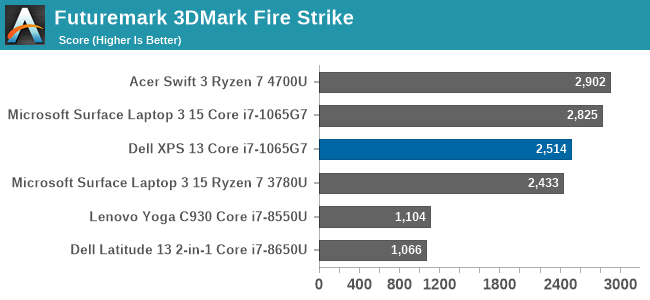
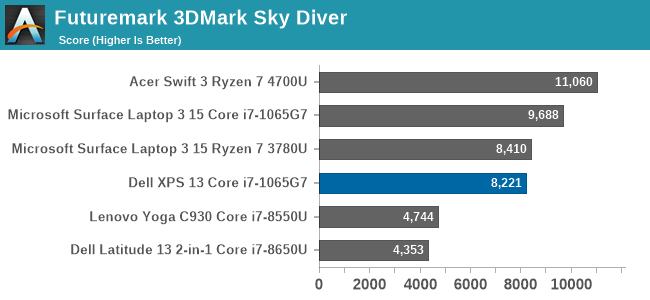

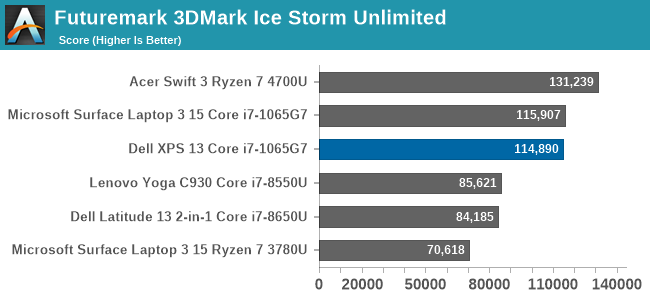
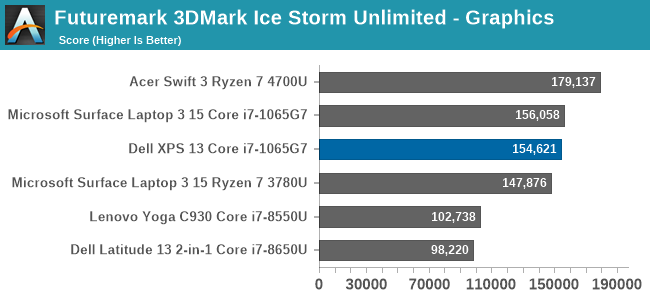
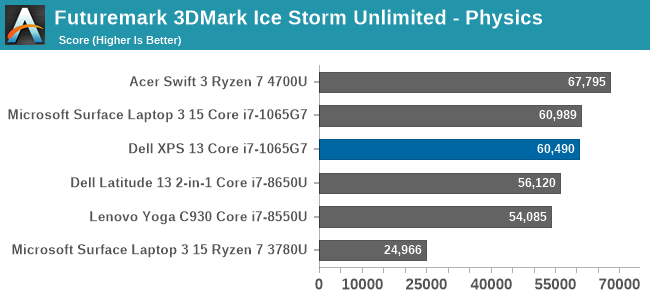
In our first synthetic test, the XPS 13 finishes slightly behind other Ice Lake notebooks, but not by a wide margin.
GFXBench
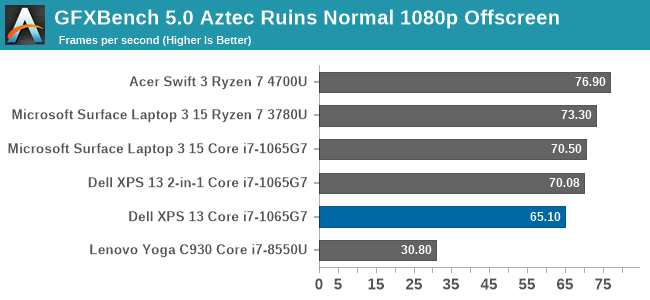

We run the DirectX 12 tests from version 5 of GFXBench, and as expected, the XPS 13 scores right in the same range as expected.
Tomb Raider
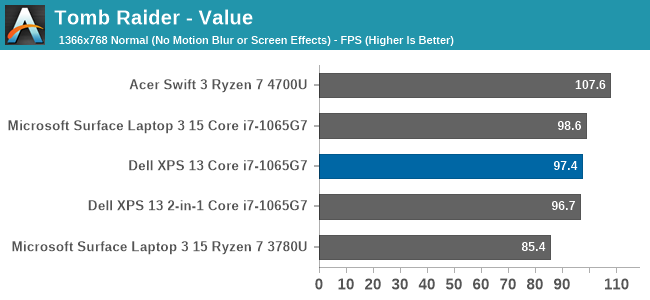
The original Tomb Raider has been a challenge on integrated GPUs, but with AMD’s Ryzen and Intel’s Ice Lake, the game is finally playable although without any extreme graphics settings enabled. Once again, the XPS 13 slots in right where it is expected.
Rise of the Tomb Raider
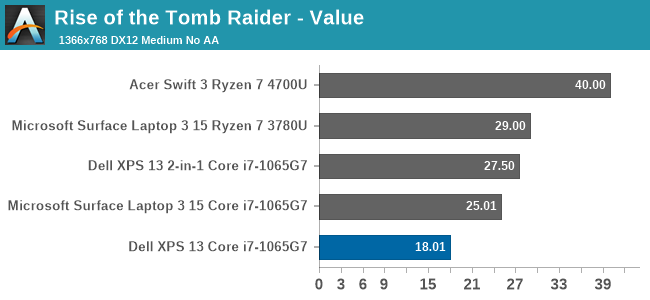
The first sequel to the re-launched Tomb Raider series is much more graphically demanding, and the XPS 13 slides out of the playability window even at the lowest settings we test at.
Strange Brigade
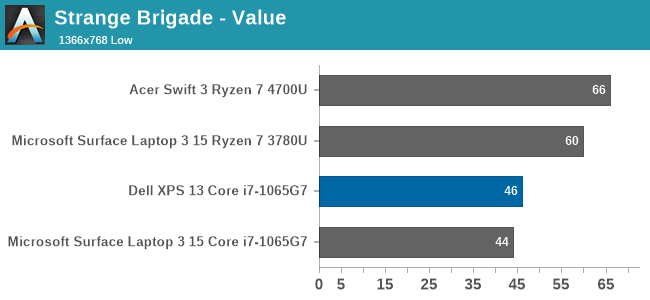
Strange Brigade is a game with a wide-range of settings, and can be very playable even on integrated graphics. As seen with Rise of the Tomb Raider though, the XPS 13 is not quite as performant as some of the other Ice Lake notebooks we have tested.
F1 2019
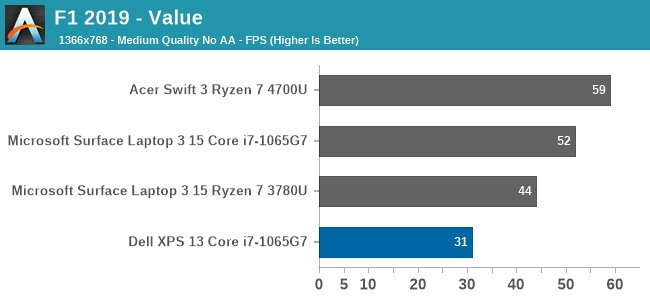
Codemaster’s F1 simulator did not fare very well on the XPS 13, scoring well under expectations. This game can be very CPU limited as well, so TDP can be a major factor.
Far Cry 5

Like most of the other games, we see that Far Cry 5 is once again below other Ice Lake systems, but even on the best integrated system Far Cry is only barely playable regardless.
GPU Conclusion
Although the XPS 13 was outfitted with the top of the range Core i7-1065G7, with its full 64 Execution Unit GPU, the XPS 13 was not quite able to match some of the other Ice Lake systems we have seen. We will get into that a bit more in the thermals section, but this is likely due to Dell more aggressively clamping the processor to its recommended 15-Watt TDP, where other manufacturers may be more aggressive and allow 20+ Watts. Since the GPU is one area where more thermal headroom is always welcomed, this can have a larger impact than a CPU-bound task.
Otherwise, while the Ice Lake G7 GPU configuration is nothing short of a massive step up from Intel's earlier integrated GPUs, they are also competing with AMD in a field that's normally AMD's strength. So for as fast as the G7 configuration is, it and the XPS 13 end up trailing laptops based on the half-a-generation newer AMD Ryzen 4000 APUs.










224 Comments
View All Comments
Deicidium369 - Friday, July 17, 2020 - link
Microsoft did with the Surface Laptop - they partnered with AMD to get the previous gen into production, with the follow up - Renoir - to be easily slotted into.AMD is more in the DiY market. and No one runs benchmarks as their main application.
The Ultralight/Athena designs are the highest end, lightest designs - like the XPS13 and Dell 13 2-in-1 - weigh a couple of pounds, lasts a whole day (i get 12+ hrs) on a single charge - and runs everything I need to run - it is NOT a DTR product.
I disagree with the optics - Most do not care if it's 8 core or quantum or made from carebears - they ask "does it do what I want it to do?" that's the only metric for most people. We are not most people. The Intel name is universally recognized - and the sales pitch for AMD is to compare it to Intel - and why get the "as good as" when you can get Intel - their last laptop was probably Intel, so their next laptop will likely be Intel - and likely the same OEM.
yeeeeman - Thursday, July 16, 2020 - link
The idea is that most premium ultrabooks are made with the help of project Athena.If AMD wants premium ultrabooks they need to start working on their own design.
Deicidium369 - Friday, July 17, 2020 - link
Make a platform / ecosystem rather than an SKUhaukionkannel - Thursday, July 16, 2020 - link
Noup. Most people don`t want to buy amd laptops...sonny73n - Friday, July 17, 2020 - link
Most STUPID people don’t want to buy AMD laptops. Go away shill! Too much trash on internet as it is.vladx - Friday, July 17, 2020 - link
Yep, having stability is just as important as performance. When AMD products become rock solid straight from the launch then I will consider an AMD product in my desktop/laptop.Spunjji - Friday, July 17, 2020 - link
Where's the data on Renoir not being rock-solid from launch?Deicidium369 - Friday, July 17, 2020 - link
contains AMD software doesn't it?vladx - Saturday, July 18, 2020 - link
That's right, people often forget there's also chipset drivers that can impact performance and stability of a system and AMD proved every time they are uncapable of writing reliable drivers.Korguz - Saturday, July 18, 2020 - link
like intel or nvidia is any better ? i had a board with both an intel NIC, and a realtech NIC onboard, and had to use the realtech one as the intel, had issues. had to go back to a previous nvidia driver cause the latest had issues. come on, every hardware maker can have issues with drivers, none of them are perfect, no matter what you or Deicidium369 claim.